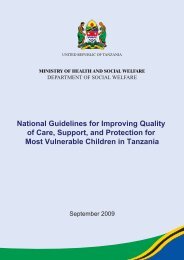Palliative Care Strategy for HIV and other diseases - FHI 360
Palliative Care Strategy for HIV and other diseases - FHI 360
Palliative Care Strategy for HIV and other diseases - FHI 360
You also want an ePaper? Increase the reach of your titles
YUMPU automatically turns print PDFs into web optimized ePapers that Google loves.
Routine meetings are also a very important <strong>for</strong>m of support. The interdisciplinary team<br />
should meet at least weekly to discuss the following:<br />
•<br />
•<br />
•<br />
•<br />
•<br />
•<br />
•<br />
•<br />
•<br />
assessments <strong>and</strong> initial care plans—presentation of new cases<br />
workload<br />
team debriefings of new issues, difficult cases, deaths<br />
education<br />
in<strong>for</strong>mation sharing<br />
ongoing care plan development<br />
ongoing reassessment of patients<br />
team planning (visits, supplies, transport, schedules)<br />
problem solving (drug reactions, symptom <strong>and</strong> pain management, family conflict<br />
issues)<br />
Mentorship is an<strong>other</strong> important way to develop a care team <strong>and</strong> palliative care services. The<br />
voluntary <strong>and</strong> mutually beneficial relationship can occur at both individual <strong>and</strong> organizational<br />
levels <strong>and</strong> involve guidance, support, leadership, supervision, advocacy, <strong>and</strong> training.<br />
Nascent palliative care providers <strong>and</strong> organizations should be encouraged to establish mentoring<br />
relationships through national associations or international palliative care organizations<br />
that can offer mentoring support. <strong>FHI</strong> technical advisors can also serve as mentors.<br />
essential palliative <strong>Care</strong> serviCes<br />
At a minimum, all services that provide palliative care must address the following:<br />
1. Staffing, training, <strong>and</strong> capacity building<br />
• develop interdisciplinary team structure<br />
• assess staffing requirements <strong>and</strong> workload<br />
• key providers trained <strong>and</strong> mentored in palliative care<br />
• care <strong>for</strong> caregivers<br />
2. Service delivery<br />
• routine assessment <strong>and</strong> follow-up of pain, <strong>other</strong> physical problems<br />
• use of a pain scale to determine severity of pain<br />
• access to essential palliative care medicines<br />
• psychosocial <strong>and</strong> spiritual needs assessment <strong>and</strong> support<br />
• strong referral system<br />
• continuity of care—clients are not neglected<br />
• family-centered service—ensure children receive needed care<br />
3. Routine supportive supervision, monitoring, <strong>and</strong> QA/QI<br />
essential palliative <strong>Care</strong> serviCes by delivery level<br />
How palliative care services are integrated depends on which service they are being incorporated<br />
into <strong>and</strong> at what level of the healthcare system. The following is an example how pallia-<br />
<strong>Palliative</strong> <strong>Care</strong> <strong>Strategy</strong> <strong>for</strong> <strong>HIV</strong> <strong>and</strong> <strong>other</strong> <strong>diseases</strong><br />
19
















